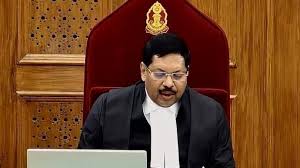1. This writ application has been filed for a direction upon respondents to release the petitioner from the imprisonment forthwith in terms of the Government Resolution contained in Memo No. 1315 dated 18.4.2007 as the petitioner who on being found guilty for the offence u/s 302 of the Indian Penal Code was sentenced for life imprisonment has served sentence for more than 26 years.
2. It was contended on behalf of the petitioner that the petitioner and two others, namely, Naresh Singh @ Lal Naresh Nath Sahdeo and Raju Ram on being convicted on 5.12.1994 in Sessions Trial No. 526 of 1992 u/s 302/34 of the Indian Penal Code for committing murder of one Kedar Sah were sentenced to undergo imprisonment for life.
3. Further contention is that on completion of imprisonment for more than 25 years including the period of remission, the petitioner has not been released, though in terms of the Government Resolution as contained in Memo No. 1315 of 18.4.2007, he should have been released after completion of 25 years of imprisonment including the period of remission whereas other co-convict, namely, Naresh Singh @ Lai Naresh Nath Sahdeo has already been released from imprisonment and under this situation, the petitioner has filed this writ application for a direction to the authority to release the petitioner forthwith.
4. A counter affidavit has been filed on behalf of the respondents that the case of the petitioner when was placed before the "State Sentence Review Board", the Board did feel that the clause with respect to release of a convict after completion of 25 years of imprisonment including the period of remission put in the Resolution No. 1315 dated 18.4.2007 is not inconsonance with the guideline laid down by the Hon''ble Supreme Court in a case of
5. It be stated that the Government of Jharkhand in terms of the guidelines laid down by the Hon''ble Supreme Court in the case of Laxman Nasker v. Union of India (supra) has taken a policy decision under Memo No. 1315 dated 18.4.2007 with respect to pre-mature release of the convict wherein it has been resolved that a convict completing 20 years of imprisonment including the period of remission though does not acquire right to be released pre-maturely but he is entitled for consideration of his early release by the Board, who will be giving due consideration while taking decision of early release of the following points.
1. Whether the offence is an individual act of crime without affecting the society at large;
2. Whether there is any chance of future recurrence of committing crime;
3. Whether the convict has lost his potentiality in committing crime;
4. Whether there is any fruitful purpose of (sic) this convict any more;
5. Socioeconomic condition of the convict''s family.
6. At the same time it has also been resolved that, in any case, the period of imprisonment shall not exceed 25 years including the period of remission. This clause clearly indicates that, in any case, if the convict has completed 25 years of imprisonment, he is entitled to be released but the Board considers this clause to be inconsistent with the ratio laid down by the Hon''ble Supreme Court in Laxman Nasker''s case. If such conclusion has been drawn by the Board, then in our view, it becomes a misreading of the ratio laid down by the Hon''ble Supreme Court in Laxman Nasker''s case wherein it has been held as under:
It is settled position of law that life sentence is nothing less than lifelong imprisonment and by earning remissions a life convict does not acquire a right to be released prematurely; but if the Government has framed any rule or made a scheme for early release of such convicts then those rules or schemes will have to be treated a guidelines for exercising its power under Article 161 of the Constitution of India and if according to the Government policy instructions in force at the relevant time the life convict has already undergone the sentence for the period mentioned in the policy instructions., then the only right which a life convict can be said to have acquired is the right to have his case put up by the prison authorities in time before the authorities concerned for considering exercise of power under Article 161 of the Constitution. When an authority is called upon to exercise its powers under Article 161 of the Constitution that will have to be done consistently with the legal position and the Government policy/instructions prevalent at that time.
7. Thus, it is evident that if the Government has framed any rule or scheme for early release of convict on fulfilling certain condition, the authority is to take decision in terms of the policy prevalent at that time. We have already indicated that the Government while framing certain guide lines for consideration of premature release has also resolved that if the period of imprisonment is 25 years including the period of remission or more one is entitled to be released forthwith. Unless and until that clause is amended, the authority is to act in accordance with the Government policy prevalent. Since the petitioner has admittedly completed the period of imprisonment for more than 25 years, he, under the policy decision of the Government, is entitled to be released forthwith.
8. Under the circumstances, the authorities are directed to release the petitioner forthwith.
9. In the result, this application is allowed.

